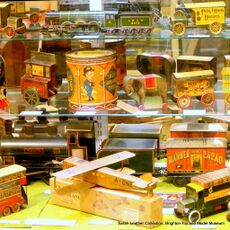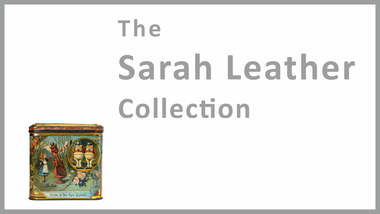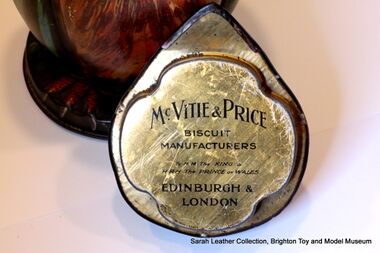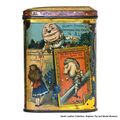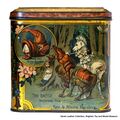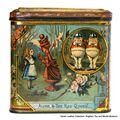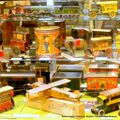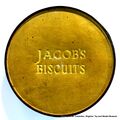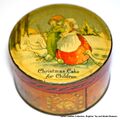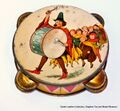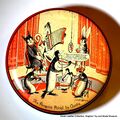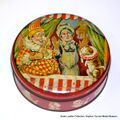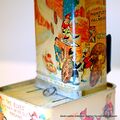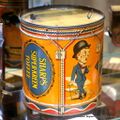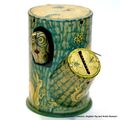Category:Biscuit Tins (display)
| Display Area |
|---|
 |
| 9 - Biscuit Tins (display) Arch Two |
| –– 01 02 03 04 05 06 07 08 09
10 11 12 13 14 15 16 17 18 19 20 21 22 23 24 25 26 27 28 –– 30 31 32 33 34 35 36 37 38 39 40 41 42 43 44 45 46 47 48 49 50 51 52 53 54 55 –– 57 58 –– –– 61 62 63 64 65 66 67 –– –– –– 71 72 73 74 –– 76 77 78 79 80 81 82 83 84 85 86 –– –– –– |
The Sarah Leather Collection, 2015 launch event splash screen [image info]
Sample biscuit tin lid, interior manufacturer mark [image info]
The museum is proud to host and display the lithographed tinpate collection of Sarah Leather.
The display's listings are currently incomplete but are being actively worked on, and should be ready for the display's official launch during 2015.
Historical context
While German companies dominated general-purpose tinplate toymaking until World War One to the extent that toy companies in other countries found that it usually wasn't worth trying to compete with German imports, there was still a niche market in Britain for tinplate promotional goods, where companies could use their local contacts and local knowledge to create products strictly for the UK market.
One of the largest and most significant of these markets was the manufacturing of tins and containers that were tie-ins to books and cartoon characters, and/or commercial advertising/promotional packaging. With the appearance of offset lithographic printing it became easier to produce quite decorative items that householder would feel comfortable (or even proud) placing on display on a kitchen or front room. Tins provided airtight resealable packaging that was important for keeping biscuits fresh, and ornamental tins were and artistically-decorated tins were useful as containers that could be shown to guests when entertaining.
The biscuit tin as we know it seems to have been invented by Joseph Huntley of Reading, whose father (also Joseph Huntley) founded a confectionery business in Reading which under his other son Thomas Huntley became Huntley and Palmers. While Thomas ran the rapidly-expanding biscuit business, "Joseph Jnr." created and produced the rigid resealable airtight tinplate boxes as Huntley Boorne and Stevens, which allowed the biscuits to be safely conveyed from Reading to Bath and London, and as the business boomed, to the far corners of the British Empire.
Fine-art lithography
As well as conventional "photographic" offset lithographic printing, some tins were designed with expertly produced manual lithography, a process that at its most complex could involve as many as ten or more layers of hand-chosen inks, laboriously hand-stippled and crosshatched in the original design, the production of which was sufficiently a complex and skilled to be considered to be a "fine arts" process in its own right. Some of these tins were designed to be convincing imitations of elaborate and expensive cases made from inlaid ivory, marquetry, ornate wood-carving and other expensive processes, the value added to the tin being sufficient to justify paying an expert artist to create these pieces for mass-production. In many cases, these tins, used to hold someone's most precious possessions, might be the most personal piece of artwork that they owned, along with books and jewellery.
The Sarah Leather Collection
Sarah started collecting the tins in the mid 1990s, finding the pieces mainly through auctions and storing the tins in her Chelsea flat as it built up over a period of twenty years.
Sarah had a great interest in attractive commercial artwork. She had a very eclectic and open-minded taste but was particularly interested in Victorian and Edwardian design. Through reading books and articles on antique biscuit tins, in her usual highly enthusiastic way she decided to build up a serious collection, which took care, time and an extremely observant eye. The Collection – described by one major antique dealer as the best he'd ever seen – is a great tribute to her perseverance and dedication.
The full impact of the Collection only came to light after Sarah's death, and this is the first time that it has even been on public display.
Further reading
- Tracy Dolphin, Biscuit Tins (Shire Library, 1999) ISBN 0747804253
- M.J. Franklin, Biscuit Tins: 1868-1939 (New Cavendish Books, revised 1999) ISBN 187272793X
External links
Subcategories
This category has the following 10 subcategories, out of 10 total.
B
C
- Carrs Biscuits (3 P, 3 F)
- Crawfords Biscuits (12 P, 6 F)
H
- Huntley and Palmers Biscuits (3 P, 4 F)
J
- Jacobs Biscuits (7 P, 14 F)
M
- Macfarlane Lang (2 P, 2 F)
- Mazawattee Tea (2 P, 7 F)
- Mcvitie and Price (1 P, 2 F)
P
- Peek Freans Biscuits (2 P)
S
- Sharps Toffee (5 P, 5 F)
Pages in category ‘Biscuit Tins (display)’
The following 36 pages are in this category, out of 36 total.
A
B
C
F
M
P
Media in category ‘Biscuit Tins (display)’
The following 35 files are in this category, out of 35 total.
- Alice in Wonderland, The Whole Pack Rose Up Into The Air (Mazawattee Tea tin).jpg 1,572 × 2,200; 833 KB
- Alice though the Looking-Glass tin (1892), panel 4, Alice and the Red Queen.jpg 3,000 × 2,998; 2.44 MB
- Area 09.jpg 1,024 × 1,024; 927 KB
- Barrel Organ biscuit tin (Crawfords).jpg 1,200 × 800; 677 KB
- Birds Nest biscuit tin (Macfarlane Lang).jpg 800 × 600; 274 KB
- Bluebird biscuit tin (McVitie and Price).jpg 683 × 1,024; 317 KB
- Cake tin base (Jacobs Biscuits).jpg 1,598 × 1,600; 1.52 MB
- Cat Wagon, Louis Wain (Mazawattee Tea).jpg 3,000 × 1,691; 3.3 MB
- Christmas Cake for Children (Jacobs Biscuits).jpg 1,600 × 1,600; 1.17 MB
- Crumpsall Biscuit Lorry, promotional biscuit tin, detail.jpg 1,600 × 1,067; 1,011 KB
- Elephant, circus floor toy (CWS).jpg 800 × 597; 302 KB
- Elf House moneybox.jpg 601 × 800; 313 KB
- Felix the Cat seaside bucket, family scene (1920s).jpg 2,200 × 1,732; 2.29 MB
- Felix the Cat seaside bucket, lid artwork (1920s).jpg 2,200 × 1,607; 2.37 MB
- Flying Scotsman LNER 4472 biscuit tin, Crawfords, detail.jpg 2,500 × 1,409; 1.73 MB
- Flying Scotsman LNER 4472 biscuit tin, Crawfords, tender detail.jpg 2,500 × 1,667; 2.14 MB
- George V and Queen Mary, Coronation souvenir tin (J S Fry).jpg 1,200 × 800; 577 KB
- House of Knowledge biscuit tin money box (Crawfords).jpg 1,200 × 902; 531 KB
- Macfarlane Lang biscuit tin toy lorry.jpg 1,200 × 817; 713 KB
- No11E Double Decker Bus HP 1929 biscuit tin, side detail (Huntley and Palmers).jpg 2,500 × 1,667; 2.47 MB
- Pied Piper biscuit tin (Carrs).jpg 1,200 × 1,114; 768 KB
- Pip Squeak and Wilfred tin, 1930s, The Penguins Patrol.jpg 2,500 × 2,499; 4.38 MB
- Pram Biscuit Tin (Huntley and Palmers).jpg 800 × 600; 318 KB
- Punch and Judy biscuit tin.jpg 1,200 × 1,200; 826 KB
- Sir Kreemy Knut tin (Sharps Toffee).jpg 576 × 1,024; 277 KB
- The Elves Penny-in-the-Slot Machine (Huntley and Palmers).jpg 2,500 × 2,497; 3.54 MB
- The Sarah Leather Collection.png 1,920 × 1,080; 378 KB
- Toffee bucket, large (Sharps Toffee).jpg 766 × 1,024; 482 KB
- Toffee bucket, small (Sharps Toffee).jpg 768 × 1,024; 548 KB
- Toffee Drum (Sharps Toffee).jpg 1,024 × 1,024; 724 KB
- Tree Stump money box with Owl (LBZ).jpg 3,475 × 3,470; 4.44 MB
- Tree Stump money box with Owl, detail (LBZ).jpg 2,500 × 1,667; 2.06 MB
- Wheel of Fortune moneybox (Jacobs Biscuits).jpg 600 × 800; 406 KB
